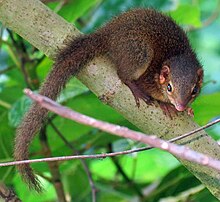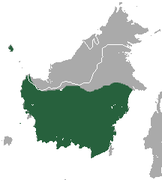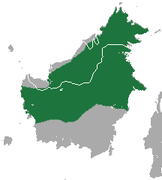
Scandentia is an order of small mammals. Members of this order are called scandentians, or treeshrews. They are primarily found in Southeast Asia, with the Madras treeshrew instead in mainland India. They range in size from the Bornean smooth-tailed treeshrew, at 11 cm (4 in) plus a 9 cm (4 in) tail, to the striped treeshrew, at 23 cm (9 in) plus a 13 cm (5 in) tail. They generally live in forests, and primarily eat insects and fruit. No population estimates have been made for any scandentian species, though the Nicobar treeshrew is categorized as endangered.
The twenty-three extant species of Scandentia are grouped into two families: Tupaiidae, which contains twenty-two species within three genera, and Ptilocercidae, which contains a single species, the pen-tailed treeshrew. Only a few extinct scandentian species have been discovered, though due to ongoing research and discoveries the exact number and categorization is not fixed.
Conventions
| Conservation status | |
|---|---|
| EX | Extinct (0 species) |
| EW | Extinct in the wild (0 species) |
| CR | Critically Endangered (0 species) |
| EN | Endangered (1 species) |
| VU | Vulnerable (1 species) |
| NT | Near threatened (0 species) |
| LC | Least concern (15 species) |
| Other categories | |
| DD | Data deficient (6 species) |
| NE | Not evaluated (0 species) |
Conservation status codes listed follow the International Union for Conservation of Nature (IUCN) Red List of Threatened Species. Range maps are provided wherever possible; if a range map is not available, a description of the scandentian's range is provided. Ranges are based on the IUCN Red List for that species unless otherwise noted. All extinct species or subspecies listed alongside extant species went extinct after 1500 CE, and are indicated by a dagger symbol "†".
Classification
The order Scandentia consists of two families: Tupaiidae, which contains twenty-two species within three genera, and Ptilocercidae, which contains a single species. Many of these species are further subdivided into subspecies. This does not include hybrid species or extinct prehistoric species.
Family Ptilocercidae
- Genus Ptilocercus (pen-tailed treeshrew): one species
Family Tupaiidae
- Genus Anathana (Madras treeshrew): one species
- Genus Dendrogale (smooth-tailed treeshrews): two species
- Genus Tupaia (treeshrews): nineteen species
|
Scandentians
The following classification is based on the taxonomy described by Mammal Species of the World (2005), with augmentation by generally accepted proposals made since using molecular phylogenetic analysis.
Family Ptilocercidae
Main article: Ptilocercidae| Common name | Scientific name and subspecies | Range | Size and ecology | IUCN status and estimated population |
|---|---|---|---|---|
| Pen-tailed treeshrew | P. lowii Gray, 1848 Two subspecies
|
Southeast Asia
|
Size: 13–14 cm (5–6 in) long, plus 16–19 cm (6–7 in) tail Habitat: Forest Diet: Insects and fruit |
LC
|
Family Tupaiidae
Main article: Tupaiidae| Common name | Scientific name and subspecies | Range | Size and ecology | IUCN status and estimated population |
|---|---|---|---|---|
| Madras treeshrew | A. ellioti (Waterhouse, 1850) |
India
|
Size: 16–19 cm (6–7 in) long, plus 16–20 cm (6–8 in) tail Habitat: Forest and shrubland Diet: Insects, other invertebrates, and fruit |
LC
|
| Common name | Scientific name and subspecies | Range | Size and ecology | IUCN status and estimated population |
|---|---|---|---|---|
| Bornean smooth-tailed treeshrew
|
D. melanura (Thomas, 1892) Two subspecies
|
Northern Borneo
|
Size: 11–15 cm (4–6 in) long, plus 9–14 cm (4–6 in) tail Habitat: Forest Diet: Fruit and insects |
DD
|
| Northern smooth-tailed treeshrew | D. murina (Schlegel, Müller, 1843) |
Mainland Southeast Asia
|
Size: About 12 cm (5 in) long, plus 4–5 cm (2 in) tail Habitat: Forest Diet: Fruit, arthropods, and small vertebrates |
LC
|
| Common name | Scientific name and subspecies | Range | Size and ecology | IUCN status and estimated population |
|---|---|---|---|---|
| Bangka Island treeshrew
|
T. discolor Lyon, 1906 |
Bangka Island, Indonesia | Size: 13–21 cm (5–8 in) long, plus 12–20 cm (5–8 in) tail Habitat: Unknown Diet: Fruit and insects |
DD
|
| Common treeshrew | T. glis (Diard, 1820) |
Southeast Asia
|
Size: 13–21 cm (5–8 in) long, plus 12–20 cm (5–8 in) tail Habitat: Forest Diet: Insects, other arthropods, and fruit |
LC
|
| Golden-bellied treeshrew
|
T. chrysogaster Miller, 1903 |
Mentawai Islands, Indonesia
|
Size: 12–21 cm (5–8 in) long, plus 14–20 cm (6–8 in) tail Habitat: Forest Diet: Fruit and insects |
VU
|
| Horsfield's treeshrew | T. javanica Horsfield, 1822 |
Western Indonesia
|
Size: 12–21 cm (5–8 in) long, plus 14–20 cm (6–8 in) tail Habitat: Forest Diet: Fruit and insects |
LC
|
| Javan treeshrew
|
T. hypochrysa Thomas, 1895 |
Java, Indonesia | Size: 13–21 cm (5–8 in) long, plus 12–20 cm (5–8 in) tail Habitat: Unknown Diet: Fruit and insects |
DD
|
| Kalimantan treeshrew
|
T. salatana Lyon, 1913 |
Southern Borneo, Indonesia | Size: 12–21 cm (5–8 in) long, plus 14–20 cm (6–8 in) tail Habitat: Forest Diet: Termites and ants |
DD
|
| Large treeshrew | T. tana Raffles, 1821 Fifteen subspecies
|
Southeast Asia
|
Size: About 22 cm (9 in) long, plus 17 cm (7 in) tail Habitat: Forest Diet: Insects and other invertebrates, as well as fruit |
LC
|
| Long-footed treeshrew | T. longipes Thomas, 1893 |
Borneo
|
Size: 12–21 cm (5–8 in) long, plus 14–20 cm (6–8 in) tail Habitat: Forest Diet: Fruit and insects |
LC
|
| Mindanao treeshrew
|
T. everetti Thomas, 1892 |
Mindanao, Philippines
|
Size: 17–22 cm (7–9 in) long, plus 11–18 cm (4–7 in) tail Habitat: Forest Diet: Small animals, insects, fruit, vegetables, and eggs |
LC
|
| Mountain treeshrew
|
T. montana Thomas, 1892 Two subspecies
|
Northern Borneo
|
Size: About 20 cm (8 in) long, plus 18 cm (7 in) tail Habitat: Forest Diet: Omnivorous |
LC
|
| Nicobar treeshrew | T. nicobarica (Zelebor, 1869) Two subspecies
|
Nicobar Islands, India
|
Size: About 14 cm (6 in) long, plus 18 cm (7 in) tail Habitat: Forest Diet: Insects as well as fruit |
EN
|
| Northern treeshrew | T. belangeri (Wagner, 1841) Two subspecies
|
Southeast Asia
|
Size: 12–21 cm (5–8 in) long, plus 14–20 cm (6–8 in) tail Habitat: Forest and shrubland Diet: Insects as well as fruit |
LC
|
| Painted treeshrew | T. picta Thomas, 1892 Two subspecies
|
Borneo
|
Size: About 21 cm (8 in) long, plus 15 cm (6 in) tail Habitat: Forest Diet: Fruit and insects |
LC
|
| Palawan treeshrew
|
T. palawanensis Thomas, 1894 |
Palawan, Philippines
|
Size: 12–21 cm (5–8 in) long, plus 14–20 cm (6–8 in) tail Habitat: Forest Diet: Insects and fruit |
LC
|
| Pygmy treeshrew | T. minor Günther, 1876 Four subspecies
|
Southeast Asia
|
Size: 11–14 cm (4–6 in) long, plus 13–17 cm (5–7 in) tail Habitat: Forest Diet: Small animals, fruit leaves, seeds, and carrion |
LC
|
| Ruddy treeshrew | T. splendidula Gray, 1865 Five subspecies
|
Southern Borneo
|
Size: About 18 cm (7 in) long, plus 14 cm (6 in) tail Habitat: Forest Diet: Fruit and insects |
LC
|
| Slender treeshrew
|
T. gracilis Thomas, 1893 Three subspecies
|
Borneo and nearby islands
|
Size: 12–21 cm (5–8 in) long, plus 14–20 cm (6–8 in) tail Habitat: Forest Diet: Fruit and insects |
LC
|
| Striped treeshrew | T. dorsalis Schlegel, 1857 |
Borneo
|
Size: 14–23 cm (6–9 in) long, plus 10–13 cm (4–5 in) tail Habitat: Forest Diet: Insects, fruit, seeds, and leaves |
DD
|
| Sumatran treeshrew
|
T. ferruginea Raffles, 1821 |
Sumatra and Tanahbala, Indonesia | Size: 13–21 cm (5–8 in) long, plus 12–20 cm (5–8 in) tail Habitat: Unknown Diet: Fruit and insects |
DD
|
References
- "Fossilworks: Scandentia". Paleobiology Database. University of Wisconsin–Madison. Retrieved February 21, 2022.
- Wilson, Reeder, pp. 104–109
- ^ Askay, Sean (2000). "Ptilocercus lowii". Animal Diversity Web. University of Michigan. Retrieved February 21, 2022.
- ^ Cassola, F. (2016). "Ptilocercus lowii". IUCN Red List of Threatened Species. 2016: e.T41491A22278277. doi:10.2305/IUCN.UK.2016-2.RLTS.T41491A22278277.en.
- ^ Bora, Suhani (2002). "Anathana ellioti". Animal Diversity Web. University of Michigan. Retrieved February 21, 2022.
- ^ Molur, S. (2016). "Anathana ellioti". IUCN Red List of Threatened Species. 2016: e.T39593A22278758. doi:10.2305/IUCN.UK.2016-2.RLTS.T39593A22278758.en.
- Bernuetz, Madeline (2015). "Dendrogale melanura". Animal Diversity Web. University of Michigan. Retrieved February 21, 2022.
- ^ Gerrie, R.; Kennerley, R. (2019). "Dendrogale melanura". IUCN Red List of Threatened Species. 2019: e.T6405A22278427. doi:10.2305/IUCN.UK.2019-1.RLTS.T6405A22278427.en.
- Hutchins, Kleiman, Geist, McDade, Trumpey, p. 294
- ^ Kyle, James (2002). "Dendrogale murina". Animal Diversity Web. University of Michigan. Retrieved February 21, 2022.
- ^ Timmins, R. J. (2016). "Dendrogale murina". IUCN Red List of Threatened Species. 2016: e.T41490A22278606. doi:10.2305/IUCN.UK.2016-2.RLTS.T41490A22278606.en.
- ^ Francis, p. 48
- ^ Sargis, E.; Kennerley, R. (2019). "Tupaia discolor". IUCN Red List of Threatened Species. 2019: e.T111873499A111873502. doi:10.2305/IUCN.UK.2019-1.RLTS.T111873499A111873502.en.
- ^ Selig, K. R.; Sargis, E. J.; Silcox, M. T. (2019). "The frugivorous insectivores? Functional morphological analysis of molar topography for inferring diet in extant treeshrews (Scandentia)". Journal of Mammalogy. 100 (6): 1901–1917. doi:10.1093/jmammal/gyz151.
- ^ Sargis, E.; Kennerley, R. (2018) . "Tupaia glis". IUCN Red List of Threatened Species. 2017: e.T111872341A123796056. doi:10.2305/IUCN.UK.2017-3.RLTS.T111872341A111872390.en.
- ^ Hubrecht, Kirkwood, eds.; Fuchs, Corbach-Söhle, p. 263
- ^ Sargis, E.; Kennerley, R. (2018). "Tupaia chrysogaster". IUCN Red List of Threatened Species. 2018: e.T22446A111870274. doi:10.2305/IUCN.UK.2018-1.RLTS.T22446A111870274.en.
- ^ Cassola, F. (2016). "Tupaia javanica". IUCN Red List of Threatened Species. 2016: e.T41496A22280464. doi:10.2305/IUCN.UK.2016-2.RLTS.T41496A22280464.en.
- ^ Sargis, E.; Kennerley, R. (2020) . "Tupaia hypochrysa". IUCN Red List of Threatened Species. 2020: e.T111873049A166528096. doi:10.2305/IUCN.UK.2020-1.RLTS.T111873049A166528096.en.
- ^ Kennerley, R.; Sargis, E. (2017). "Tupaia salatana". IUCN Red List of Threatened Species. 2017: e.T111871663A111871718. doi:10.2305/IUCN.UK.2017-3.RLTS.T111871663A111871718.en.
- ^ Cassola, F. (2016). "Tupaia tana". IUCN Red List of Threatened Species. 2016: e.T41501A22279356. doi:10.2305/IUCN.UK.2016-2.RLTS.T41501A22279356.en.
- Miller, Emmeline (2007). "Tupaia tana". Animal Diversity Web. University of Michigan. Retrieved February 21, 2022.
- ^ Sargis, E.; Kennerley, R. (2018) . "Tupaia longipes". IUCN Red List of Threatened Species. 2017: e.T111871214A123798768. doi:10.2305/IUCN.UK.2017-3.RLTS.T111871214A111871245.en.
- ^ Pietryga, Jason (2002). "Urogale everetti". Animal Diversity Web. University of Michigan. Retrieved February 21, 2022.
- ^ Kennerley, R. (2019). "Tupaia everetti". IUCN Red List of Threatened Species. 2019: e.T22784A130877829. doi:10.2305/IUCN.UK.2019-1.RLTS.T22784A130877829.en.
- Phillipps, p. 146
- ^ Cassola, F. (2016). "Tupaia montana". IUCN Red List of Threatened Species. 2016: e.T41498A22279521. doi:10.2305/IUCN.UK.2016-2.RLTS.T41498A22279521.en.
- ^ Stone, p. 64
- Oommen, M. A.; Shanker, K. (2008). "Ecology and Behavior of an Endemic Treeshrew Tupaia nicobarica Zelebor 1869 on Great Nicobar Island, India". Journal of the Bombay Natural History Society. 105 (1): 55–63.
- ^ Laginha Pinto Correia, D.; Kennerley, R. (2017) . "Tupaia nicobarica". IUCN Red List of Threatened Species. 2016: e.T22454A115166757. doi:10.2305/IUCN.UK.2016-3.RLTS.T22454A22279002.en.
- ^ Lowther, Teagan (2013). "Tupaia belangeri". Animal Diversity Web. University of Michigan. Retrieved February 21, 2022.
- ^ Han, K. H; Duckworth, J. W.; Molur, S. (2016). "Tupaia belangeri". IUCN Red List of Threatened Species. 2016: e.T41492A22280884. doi:10.2305/IUCN.UK.2016-2.RLTS.T41492A22280884.en.
- ^ Phillipps, p. 148
- ^ Cassola, F. (2016). "Tupaia picta". IUCN Red List of Threatened Species. 2016: e.T41499A22279973. doi:10.2305/IUCN.UK.2016-2.RLTS.T41499A22279973.en.
- ^ Kennerley, R. (2018) . "Tupaia palawanensis". IUCN Red List of Threatened Species. 2017: e.T110678346A123808057.
- ^ Burnie, p. 133
- ^ Cassola, F. (2016). "Tupaia minor". IUCN Red List of Threatened Species. 2016: e.T41497A22279656. doi:10.2305/IUCN.UK.2016-2.RLTS.T41497A22279656.en.
- ^ Cassola, F. (2016). "Tupaia splendidula". IUCN Red List of Threatened Species. 2016: e.T41500A22279827. doi:10.2305/IUCN.UK.2016-2.RLTS.T41500A22279827.en.
- ^ Han, K. H.; Stuebing, R. (2017) . "Tupaia gracilis". IUCN Red List of Threatened Species. 2016: e.T41495A115189017. doi:10.2305/IUCN.UK.2016-3.RLTS.T41495A22280735.en.
- ^ Miller, Melissa (2019). "Tupaia dorsalis". Animal Diversity Web. University of Michigan. Retrieved February 21, 2022.
- ^ Gerrie, R.; Kennerley, R. (2019). "Tupaia dorsalis". IUCN Red List of Threatened Species. 2019: e.T41493A22280298. doi:10.2305/IUCN.UK.2019-1.RLTS.T41493A22280298.en.
- ^ Sargis, E.; Kennerley, R. (2020) . "Tupaia ferruginea". IUCN Red List of Threatened Species. 2020: e.T111873543A166528436. doi:10.2305/IUCN.UK.2020-1.RLTS.T111873543A166528436.en.
Sources
- Burnie, David (2017). Animal: The Definitive Visual Guide. DK. ISBN 978-1-4654-7086-7.
- Francis, Charles (2019). Field Guide to the Mammals of South-east Asia (2nd ed.). Bloomsbury Publishing. ISBN 978-1-4729-3498-7.
- Hubrecht, Robert; Kirkwood, James, eds. (2010). The UFAW Handbook on the Care and Management of Laboratory and Other Research Animals (8th ed.). John Wiley & Sons. ISBN 978-1-4051-7523-4.
- Hutchins, Michael; Kleiman, Devra G.; Geist, Valerius; McDade, Melissa C., eds. (2003). Grzimek's Animal Life Encyclopedia. Vol. 13: Mammals II (2nd ed.). Gale Research. ISBN 978-0-7876-5789-5.
- Phillipps, Quentin (2016). Phillipps' Field Guide to the Mammals of Borneo and Their Ecology. Princeton University Press. ISBN 978-0-691-16941-5.
- Stone, David; IUCN/SSC Insectivore, Tree Shrew and Elephant Shrew Specialist Group (1995). Eurasian Insectivores and Tree Shrews: Status Survey and Conservation Action Plan. International Union for Conservation of Nature. ISBN 978-2-8317-0062-5.
- Helgen, Kristofer M. (2005). Wilson, Don E.; Reeder, DeeAnn M. (eds.). Mammal Species of the World. Vol. 1 (3rd ed.). Johns Hopkins University Press. ISBN 978-0-8018-8221-0.
| Lists of mammal species | |||||||||||||||
|---|---|---|---|---|---|---|---|---|---|---|---|---|---|---|---|
| Monotremes and marsupials |
| ||||||||||||||
| Placental mammals |
| ||||||||||||||












